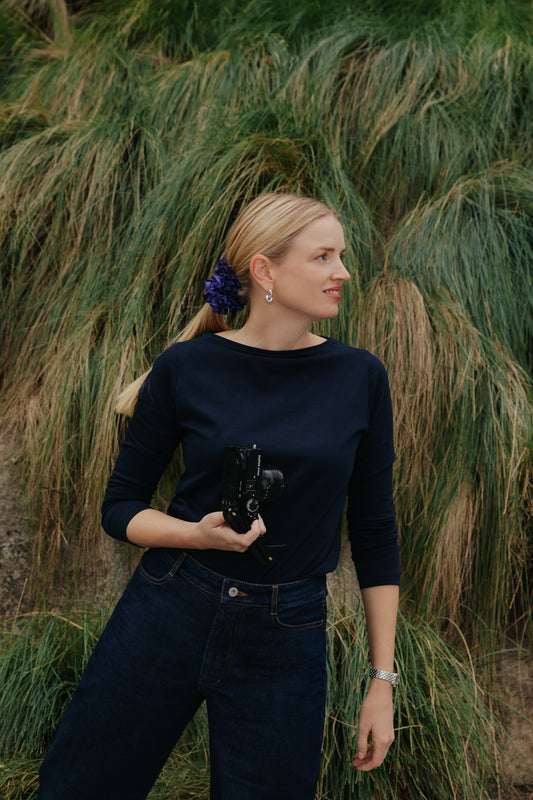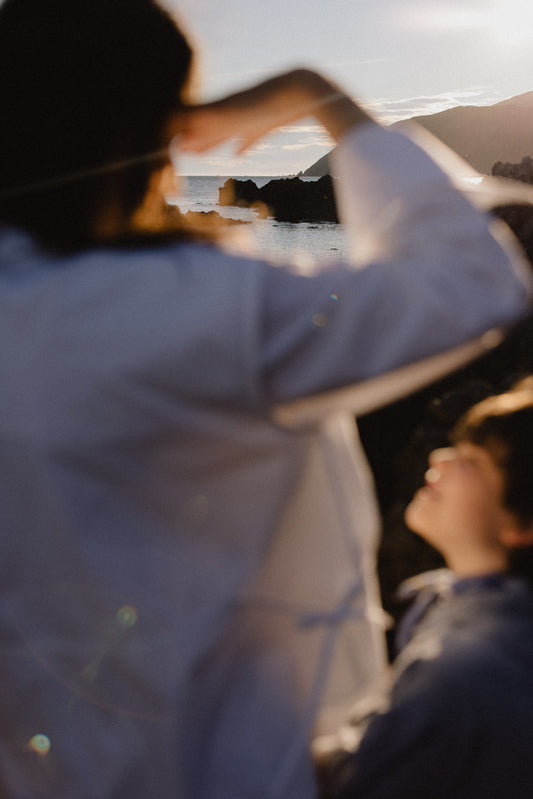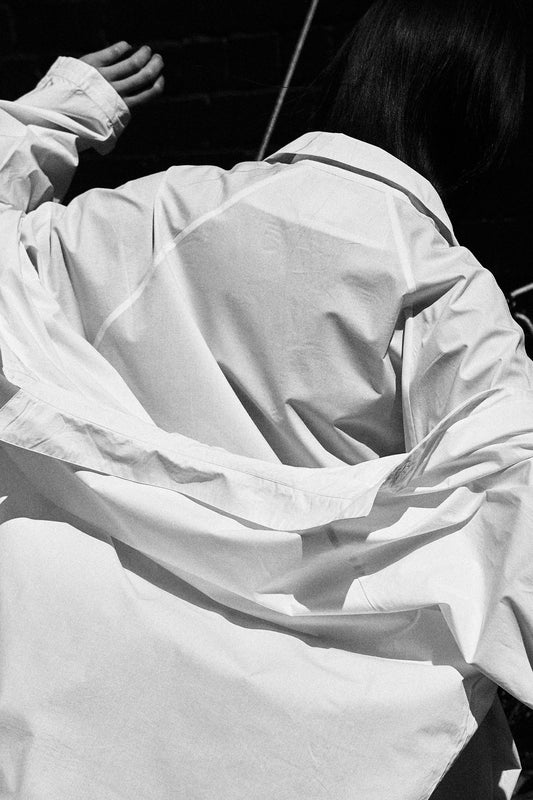The importance of community and resource sharing

Kowtow: Kia ora Charli, firstly what does Koha do?
Charli: Koha Apparel pops up alongside meals and other essential community services, offering clothing to anyone at no cost. For those who might not know, Koha Apparel became a constant fixture at St Kevin's Arcade alongside Everybody Eats in 2019. We were essentially feeding and clothing central Auckland's most vulnerable.
That first pop-up was made possible by clothing donations provided by work colleagues and friends but four years on looks quite different. Today we serve over 4,500 people through community pop-ups alone and more through community organisations we partner with, such as Rainbow Youth and Lifewise. We're utilising textile donations from the public and our brand partners that reduce material hardship and create social inclusion opportunities while advocating for a circular economy in Aotearoa.
Kowtow: How does clean and good-quality clothing empower our vulnerable communities?
Charli: Today, high living costs, particularly housing, keep our people in poverty. According to Stats NZ, more than 30% of the lowest-income households spend over half their income on housing.
Government research indicates an individual-level effect of material deprivation on the consequences of ill health. Social exclusion and relative deprivation have made poor mental health endemic within our communities. For people receiving this clothing, there is the choice and a sense of humility, and of course, it reaffirms one's identity and self-esteem.
Beyond that, from a societal aspect, there is a greater sense of inclusion, which could be school or university, leading to better learning outcomes. For those seeking work or acquiring a tenancy or even a rent-share, then clothing becomes a vehicle for enabling those opportunities and, overall, improving quality of life.
Kowtow: How is the lifetime of second-hand clothing currently being managed in Aotearoa, and what is the environmental impact of this waste?
Charli: Many people don’t understand that you can’t throw garments away.
Currently, 73 per cent of garments are landfilled or burned. We’re landfilling 220,800 tonnes annually and exporting another 4.2 tonnes for ‘reuse’. Less than 1% of textile waste is recycled. That is how we are managing textile waste in Aotearoa.
Scion’s recent data confirmed that our clothing is a significant source of microplastic pollution, in that 87% of the microplastics polluting Tāmaki Makaurau waterways came from synthetic textiles. 1news recently published a piece quoting Waste Management’s Ingrid Cronin that the Auckland landfill sees 70 truckloads of discarded clothing each week. Regarding impact, Bernadette Casey, sustainability consultant and co-founder of Used Fully, recently spoke with nzherald explaining that textiles create about three times their weight in CO2 in landfill. And so while they make up 5-6 per cent of landfill, they produce about 30 per cent of the carbon impacts. And the government is not addressing the environmental impact. The new waste strategy does not mention textiles.
Kowtow: What is Koha’s response to these political and environmental climates?
Charli: The reality is that so much has already been made, and brands don’t have to deal with it in any particular way. Aotearoa lacks the regulation to prevent perfectly useful garments from being destroyed, landfilled, or incinerated. Many people are unaware that clothing sent to charity bins or stores is often bailed up and sent offshore, where it becomes a developing nation's problem. These garments are worthless, never worn again, or transformed into anything of value.
We’re taking used garments or, increasingly, the stock that has been sitting in a warehouse for seasons, helping find solutions for what we can do with it. We can get seven boxes of stock gone after a week of central community pop-ups. We’re also sending garments to other charitable organisations and stocking the Rainbow Youth wardrobe. We’re also upcycling, recycling, creating opportunities in the waste-to-value space, and taking responsibility for what we collect. We won’t send it overseas to nations where it is essentially worthless due to the poor quality of fast fashion garments donated that are mostly recycled.

Kowtow: How does the work Koha does speak to the circular economy?
Charli: Increasingly using clothing and helping the industry recognise the opportunities for these textiles is an essential part of our work. By caring for our communities, we’re also working towards making fashion circular.
Keeping clothing in circulation and increasing utilisation is a priority. We want people to find something for $10 in our store Saturdays. We have to make second-hand more desirable than fast fashion price points. The topic of the gentrification of second-hand is discussed widely on the Internet. All it does is take from the people for whom it was intended to serve. Not everyone needs to resell their clothing to reinvest, so we provide a space where people can donate items from their wardrobe that we either pass on through our community or sell those pieces, and that is how some people are giving back, supporting the work we do.
We’re running monthly repair workshops, and there’s a serious approach to the sustainability aspect of what we do. Last year we partnered with Upparel to recycle the clothing we have decided does not reach our quality requirements, to the point we feel it would be demeaning to have that piece on offer for anyone. We pay to recycle textiles, and we hope that by educating our community and others doing the same, those in a position to spend money on clothing will re-evaluate where they spend that money and the impacts.
Kowtow: We have partnered with you before. Where have these donations ended up? Can you tell us about the new life these clothes have been given?
Charli: To people in need. This is either via our hosted weekly community outreach pop-ups, which we now run twenty or through our community partners such as Lifewise, Rainbow Youth and Oranga Tamariki.
There are a lot of people struggling now. In the beginning, it was people experiencing homelessness, where clothing is their physical barrier and protection from the elements, and we’re talking about contributing to the most basic of needs. And now, with the cost of rent, food and transportation, we’ll see students, families, and people generally unable to make ends meet anymore. While unsure of the specifics, I hope people feel better about themselves for receiving clothing through us.
Kowtow: What else can we do to encourage our community to contribute to the solution?
Charli: There’s a lot of unlearning needed to address the broader issues around poverty and attitudes towards those affected by it and how those attitudes influence government agendas. At a more practical level, take care of your clothing. Wear it. And when you no longer have a use for it, sell it yourself if you are inclined or send it to us so someone else can breathe new life into it.
Kowtow: What else can we do to encourage our community to contribute to the solution?
Charli: There’s a lot of unlearning needed to address the wider issues. If we want to bring forward a new culture based on regeneration, empathy and care, that will require legislative change because brands will put shareholders first, and influencers will still produce haul videos in TikTok.
- Donate money to us
- Volunteer at our weekly outreach pop-ups
- Donate your time and skills at our mending workshops
- Give your clothing a second life
For more about Koha, check out their instagram or visit their website here.



